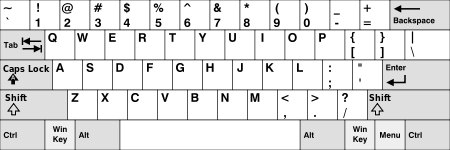End key

The end key is a key commonly found on computer keyboards. The key has the opposite effect of the home key. In some limited-size keyboards where the end key is missing the same functionality can be reached via the key combination of Fn+→
Microsoft Windows
In modern Microsoft Windows text editing applications, it is primarily used to put the cursor at the end of the line in which the cursor is. When the text is not editable, the end key is used to scroll to the end of the document; this can also be done in editable text if the key is pressed along with control.
The end key can also be used to highlight all the characters after the cursor in a certain line if pressed along with shift in editable text.
Mac OS X
In most Mac OS X applications, the key works differently than on other platforms. When the key is pressed, the window scrolls to the bottom, while the cursor position does not change at all; that is, the end key is tied to the window, not the text box being edited.[1] To get the same result as the Windows platform (that is, going to the end of the current line of text), press ⌘ Command+→. In most single-line text fields, you can also instead press the down arrow key.
Linux
In Linux, the end key has basically the same functionality as it does on Windows. It positions the cursor at the end of a line in editable text, and otherwise scrolls a scrollable document to the end. Also, like Windows, the end key can be used to highlight all the characters after the cursor in a certain line if pressed along with shift in editable text.
Non-GUI applications
In older screen-oriented, text-based (non-GUI) applications, the user pressed the "End" key to indicate that they had finished entering data on a particular "screen".
See also
References
| IBM PC keyboard (Windows, US layout) | ||||||||||||||||||||||||
|---|---|---|---|---|---|---|---|---|---|---|---|---|---|---|---|---|---|---|---|---|---|---|---|---|
| Esc | F1 | F2 | F3 | F4 | F5 | F6 | F7 | F8 | F9 | F10 | F11 | F12 | PrtScn/ SysRq |
ScrLk | Pause/ Break |
|||||||||
 |
Insert | Home | PgUp | Num Lock |
∕ | ∗ | − | |||||||||||||||||
| Delete | End | PgDn | 7 | 8 | 9 | + | ||||||||||||||||||
| 4 | 5 | 6 | ||||||||||||||||||||||
| ↑ | 1 | 2 | 3 | Enter | ||||||||||||||||||||
| ← | ↓ | → | 0 Ins |
. Del | ||||||||||||||||||||
| ||||||||||||||||||||